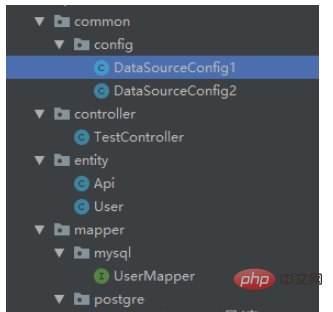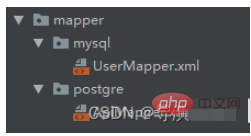How SpringBoot uses druid to configure multiple data sources
1. Background
Use spring boot to configure multiple data sources. The data sources are postgresql and mysql
2. Version introduction
spring boot——2.5.4
- ##druid——1.2.11 ##postgresql——12
- mysql——8.0.16
- ##maven——3.0
##idea——2019
3. Project structure
java package directory
##The resource directory stores the mapper.xml file and creates a package according to the data source

4. Maven dependency
<dependency>
<groupId>org.springframework.boot</groupId>
<artifactId>spring-boot-starter-data-jpa</artifactId>
</dependency>
<dependency>
<groupId>org.springframework.boot</groupId>
<artifactId>spring-boot-starter-test</artifactId>
<scope>test</scope>
</dependency>
<dependency>
<groupId>org.springframework.boot</groupId>
<artifactId>spring-boot-starter-web</artifactId>
</dependency>
<!-- https://mvnrepository.com/artifact/com.alibaba/fastjson -->
<dependency>
<groupId>com.alibaba</groupId>
<artifactId>fastjson</artifactId>
<version>2.0.4</version>
</dependency>
<!-- https://mvnrepository.com/artifact/com.alibaba/druid-spring-boot-starter -->
<dependency>
<groupId>com.alibaba</groupId>
<artifactId>druid-spring-boot-starter</artifactId>
<version>1.2.11</version>
</dependency>
<dependency>
<groupId>org.mybatis.spring.boot</groupId>
<artifactId>mybatis-spring-boot-starter</artifactId>
<version>1.3.2</version>
</dependency>
<dependency>
<groupId>org.postgresql</groupId>
<artifactId>postgresql</artifactId>
<scope>runtime</scope>
</dependency>
<!-- MySql驱动 -->
<dependency>
<groupId>mysql</groupId>
<artifactId>mysql-connector-java</artifactId>
</dependency>5. Yaml configuration file
server:
port: 8081
spring:
datasource:
type: com.alibaba.druid.pool.DruidDataSource
druid:
web-stat-filter:
enabled: true #是否启用StatFilter默认值true
url-pattern: /*
exclusions: /druid/*,*.js,*.gif,*.jpg,*.bmp,*.png,*.css,*.ico
session-stat-enable: true
session-stat-max-count: 10
stat-view-servlet:
enabled: true #是否启用StatViewServlet默认值true
url-pattern: /druid/*
reset-enable: true
login-username: admin
login-password: admin
allow:
db1:
username: postgres
password: localhost
url: jdbc:postgresql://localhost:5432/test
driver-class-name: org.postgresql.Driver
initial-size: 5 # 初始化大小
min-idle: 5 # 最小
max-active: 100 # 最大
max-wait: 60000 # 配置获取连接等待超时的时间
validation-query: select version()
time-between-eviction-runs-millis: 60000 # 配置间隔多久才进行一次检测,检测需要关闭的空闲连接,单位是毫秒
min-evictable-idle-time-millis: 300000 # 指定一个空闲连接最少空闲多久后可被清除,单位是毫秒
filters: config,wall,stat # 配置监控统计拦截的filters,去掉后监控界面sql无法统计,'wall'用于防火墙
# 通过connectProperties属性来打开mergeSql功能;慢SQL记录
connectionProperties: druid.stat.slowSqlMillis=200;druid.stat.logSlowSql=true;config.decrypt=false
test-while-idle: true
test-on-borrow: true
test-on-return: false
# 是否缓存preparedStatement,也就是PSCache 官方建议MySQL下建议关闭 个人建议如果想用SQL防火墙 建议打开
pool-prepared-statements: true
max-pool-prepared-statement-per-connection-size: 20
db2:
username: root
password: localhost
url: jdbc:mysql://localhost:3306/springboot?characterEncoding=utf8&useUnicode=true&useSSL=false&serverTimezone=Asia/Shanghai
driver-class-name: com.mysql.cj.jdbc.Driver
initial-size: 5 # 初始化大小
min-idle: 5 # 最小
max-active: 100 # 最大
max-wait: 60000 # 配置获取连接等待超时的时间
validation-query: select 'x'
time-between-eviction-runs-millis: 60000 # 配置间隔多久才进行一次检测,检测需要关闭的空闲连接,单位是毫秒
min-evictable-idle-time-millis: 300000 # 指定一个空闲连接最少空闲多久后可被清除,单位是毫秒
filters: config,wall,stat # 配置监控统计拦截的filters,去掉后监控界面sql无法统计,'wall'用于防火墙
# 通过connectProperties属性来打开mergeSql功能;慢SQL记录
connectionProperties: druid.stat.slowSqlMillis=200;druid.stat.logSlowSql=true;config.decrypt=false
test-while-idle: true
test-on-borrow: true
test-on-return: false
# 是否缓存preparedStatement,也就是PSCache 官方建议MySQL下建议关闭 个人建议如果想用SQL防火墙 建议打开
pool-prepared-statements: true
max-pool-prepared-statement-per-connection-size: 20
mybatis:
mapper-locations: classpath:com/demo/mapper/*.xml
type-aliases-package: com.demo.entity
configuration:
log-impl:
mapUnderscoreToCamelCase: true
#showSql
logging:
level:
java.sql: debug
org.apache.ibatis: debug
com.demo.mapper: debug
config: classpath:logback-spring.xml@Configuration
@MapperScan(basePackages = "com.demo.mapper.postgre.**", sqlSessionFactoryRef = "oneSqlSessionFactory")
public class DataSourceConfig1 {
// 将这个对象放入Spring容器中
@Bean(name = "oneDataSource")
// 表示这个数据源是默认数据源
@Primary
// 读取application.properties中的配置参数映射成为一个对象
// prefix表示参数的前缀
@ConfigurationProperties(prefix = "spring.datasource.druid.db1")
public DataSource getDateSource1() {
return DataSourceBuilder.create().type(DruidDataSource.class).build();
}
@Bean(name = "oneSqlSessionFactory")
// 表示这个数据源是默认数据源
@Primary
// @Qualifier表示查找Spring容器中名字为oneDataSource的对象
public SqlSessionFactory oneSqlSessionFactory(@Qualifier("oneDataSource") DataSource datasource)
throws Exception {
SqlSessionFactoryBean bean = new SqlSessionFactoryBean();
bean.setDataSource(datasource);
bean.setMapperLocations(
// 设置mybatis的xml所在位置
new PathMatchingResourcePatternResolver().getResources("classpath*:com.demo.mapper.postgre/*.xml"));
return bean.getObject();
}
@Bean("oneSqlSessionTemplate")
// 表示这个数据源是默认数据源
@Primary
public SqlSessionTemplate oneSqlSessionTemplate(
@Qualifier("oneSqlSessionFactory") SqlSessionFactory sessionFactory) {
return new SqlSessionTemplate(sessionFactory);
}
}Copy after login@Configuration
@MapperScan(basePackages = "com.demo.mapper.mysql", sqlSessionFactoryRef = "twoSqlSessionFactory")
public class DataSourceConfig2 {
// 将这个对象放入Spring容器中
@Bean(name = "twoDataSource")
// 读取application.properties中的配置参数映射成为一个对象
// prefix表示参数的前缀
@ConfigurationProperties(prefix = "spring.datasource.druid.db2")
public DataSource getDateSource1() {
return DataSourceBuilder.create().type(DruidDataSource.class).build();
}
@Bean(name = "twoSqlSessionFactory")
// 表示这个数据源是默认数据源
//@Primary
// @Qualifier表示查找Spring容器中名字为oneDataSource的对象
public SqlSessionFactory oneSqlSessionFactory(@Qualifier("twoDataSource") DataSource datasource)
throws Exception {
SqlSessionFactoryBean bean = new SqlSessionFactoryBean();
bean.setDataSource(datasource);
bean.setMapperLocations(
// 设置mybatis的xml所在位置
new PathMatchingResourcePatternResolver().getResources("classpath*:com.demo.mapper.mysql/*.xml"));
return bean.getObject();
}
@Bean("twoSqlSessionTemplate")
// 表示这个数据源是默认数据源
//@Primary
public SqlSessionTemplate oneSqlSessionTemplate(
@Qualifier("twoSqlSessionFactory") SqlSessionFactory sessionFactory) {
return new SqlSessionTemplate(sessionFactory);
}
}Copy after login
7. Startup class configurationKey points: remove exclude = {DataSourceAutoConfiguration.class} and scan the com.demo.mapper directory@Configuration
@MapperScan(basePackages = "com.demo.mapper.postgre.**", sqlSessionFactoryRef = "oneSqlSessionFactory")
public class DataSourceConfig1 {
// 将这个对象放入Spring容器中
@Bean(name = "oneDataSource")
// 表示这个数据源是默认数据源
@Primary
// 读取application.properties中的配置参数映射成为一个对象
// prefix表示参数的前缀
@ConfigurationProperties(prefix = "spring.datasource.druid.db1")
public DataSource getDateSource1() {
return DataSourceBuilder.create().type(DruidDataSource.class).build();
}
@Bean(name = "oneSqlSessionFactory")
// 表示这个数据源是默认数据源
@Primary
// @Qualifier表示查找Spring容器中名字为oneDataSource的对象
public SqlSessionFactory oneSqlSessionFactory(@Qualifier("oneDataSource") DataSource datasource)
throws Exception {
SqlSessionFactoryBean bean = new SqlSessionFactoryBean();
bean.setDataSource(datasource);
bean.setMapperLocations(
// 设置mybatis的xml所在位置
new PathMatchingResourcePatternResolver().getResources("classpath*:com.demo.mapper.postgre/*.xml"));
return bean.getObject();
}
@Bean("oneSqlSessionTemplate")
// 表示这个数据源是默认数据源
@Primary
public SqlSessionTemplate oneSqlSessionTemplate(
@Qualifier("oneSqlSessionFactory") SqlSessionFactory sessionFactory) {
return new SqlSessionTemplate(sessionFactory);
}
}@Configuration
@MapperScan(basePackages = "com.demo.mapper.mysql", sqlSessionFactoryRef = "twoSqlSessionFactory")
public class DataSourceConfig2 {
// 将这个对象放入Spring容器中
@Bean(name = "twoDataSource")
// 读取application.properties中的配置参数映射成为一个对象
// prefix表示参数的前缀
@ConfigurationProperties(prefix = "spring.datasource.druid.db2")
public DataSource getDateSource1() {
return DataSourceBuilder.create().type(DruidDataSource.class).build();
}
@Bean(name = "twoSqlSessionFactory")
// 表示这个数据源是默认数据源
//@Primary
// @Qualifier表示查找Spring容器中名字为oneDataSource的对象
public SqlSessionFactory oneSqlSessionFactory(@Qualifier("twoDataSource") DataSource datasource)
throws Exception {
SqlSessionFactoryBean bean = new SqlSessionFactoryBean();
bean.setDataSource(datasource);
bean.setMapperLocations(
// 设置mybatis的xml所在位置
new PathMatchingResourcePatternResolver().getResources("classpath*:com.demo.mapper.mysql/*.xml"));
return bean.getObject();
}
@Bean("twoSqlSessionTemplate")
// 表示这个数据源是默认数据源
//@Primary
public SqlSessionTemplate oneSqlSessionTemplate(
@Qualifier("twoSqlSessionFactory") SqlSessionFactory sessionFactory) {
return new SqlSessionTemplate(sessionFactory);
}
}@MapperScan("com.demo.mapper")
@SpringBootApplication(exclude = {DataSourceAutoConfiguration.class})
public class DemoApplication {
public static void main(String[] args) {
SpringApplication.run(DemoApplication .class, args);
}
}Copy after login8. Druid management pageEnter the address localhost://8081/druid, enter admin/admin
@MapperScan("com.demo.mapper")
@SpringBootApplication(exclude = {DataSourceAutoConfiguration.class})
public class DemoApplication {
public static void main(String[] args) {
SpringApplication.run(DemoApplication .class, args);
}
}The above is the detailed content of How SpringBoot uses druid to configure multiple data sources. For more information, please follow other related articles on the PHP Chinese website!

Hot AI Tools

Undresser.AI Undress
AI-powered app for creating realistic nude photos

AI Clothes Remover
Online AI tool for removing clothes from photos.

Undress AI Tool
Undress images for free

Clothoff.io
AI clothes remover

Video Face Swap
Swap faces in any video effortlessly with our completely free AI face swap tool!

Hot Article

Hot Tools

Notepad++7.3.1
Easy-to-use and free code editor

SublimeText3 Chinese version
Chinese version, very easy to use

Zend Studio 13.0.1
Powerful PHP integrated development environment

Dreamweaver CS6
Visual web development tools

SublimeText3 Mac version
God-level code editing software (SublimeText3)

Hot Topics
 How Springboot integrates Jasypt to implement configuration file encryption
Jun 01, 2023 am 08:55 AM
How Springboot integrates Jasypt to implement configuration file encryption
Jun 01, 2023 am 08:55 AM
Introduction to Jasypt Jasypt is a java library that allows a developer to add basic encryption functionality to his/her project with minimal effort and does not require a deep understanding of how encryption works. High security for one-way and two-way encryption. , standards-based encryption technology. Encrypt passwords, text, numbers, binaries... Suitable for integration into Spring-based applications, open API, for use with any JCE provider... Add the following dependency: com.github.ulisesbocchiojasypt-spring-boot-starter2. 1.1Jasypt benefits protect our system security. Even if the code is leaked, the data source can be guaranteed.
 How SpringBoot integrates Redisson to implement delay queue
May 30, 2023 pm 02:40 PM
How SpringBoot integrates Redisson to implement delay queue
May 30, 2023 pm 02:40 PM
Usage scenario 1. The order was placed successfully but the payment was not made within 30 minutes. The payment timed out and the order was automatically canceled. 2. The order was signed and no evaluation was conducted for 7 days after signing. If the order times out and is not evaluated, the system defaults to a positive rating. 3. The order is placed successfully. If the merchant does not receive the order for 5 minutes, the order is cancelled. 4. The delivery times out, and push SMS reminder... For scenarios with long delays and low real-time performance, we can Use task scheduling to perform regular polling processing. For example: xxl-job Today we will pick
 How to use Redis to implement distributed locks in SpringBoot
Jun 03, 2023 am 08:16 AM
How to use Redis to implement distributed locks in SpringBoot
Jun 03, 2023 am 08:16 AM
1. Redis implements distributed lock principle and why distributed locks are needed. Before talking about distributed locks, it is necessary to explain why distributed locks are needed. The opposite of distributed locks is stand-alone locks. When we write multi-threaded programs, we avoid data problems caused by operating a shared variable at the same time. We usually use a lock to mutually exclude the shared variables to ensure the correctness of the shared variables. Its scope of use is in the same process. If there are multiple processes that need to operate a shared resource at the same time, how can they be mutually exclusive? Today's business applications are usually microservice architecture, which also means that one application will deploy multiple processes. If multiple processes need to modify the same row of records in MySQL, in order to avoid dirty data caused by out-of-order operations, distribution needs to be introduced at this time. The style is locked. Want to achieve points
 How to solve the problem that springboot cannot access the file after reading it into a jar package
Jun 03, 2023 pm 04:38 PM
How to solve the problem that springboot cannot access the file after reading it into a jar package
Jun 03, 2023 pm 04:38 PM
Springboot reads the file, but cannot access the latest development after packaging it into a jar package. There is a situation where springboot cannot read the file after packaging it into a jar package. The reason is that after packaging, the virtual path of the file is invalid and can only be accessed through the stream. Read. The file is under resources publicvoidtest(){Listnames=newArrayList();InputStreamReaderread=null;try{ClassPathResourceresource=newClassPathResource("name.txt");Input
 How to implement Springboot+Mybatis-plus without using SQL statements to add multiple tables
Jun 02, 2023 am 11:07 AM
How to implement Springboot+Mybatis-plus without using SQL statements to add multiple tables
Jun 02, 2023 am 11:07 AM
When Springboot+Mybatis-plus does not use SQL statements to perform multi-table adding operations, the problems I encountered are decomposed by simulating thinking in the test environment: Create a BrandDTO object with parameters to simulate passing parameters to the background. We all know that it is extremely difficult to perform multi-table operations in Mybatis-plus. If you do not use tools such as Mybatis-plus-join, you can only configure the corresponding Mapper.xml file and configure The smelly and long ResultMap, and then write the corresponding sql statement. Although this method seems cumbersome, it is highly flexible and allows us to
 How SpringBoot customizes Redis to implement cache serialization
Jun 03, 2023 am 11:32 AM
How SpringBoot customizes Redis to implement cache serialization
Jun 03, 2023 am 11:32 AM
1. Customize RedisTemplate1.1, RedisAPI default serialization mechanism. The API-based Redis cache implementation uses the RedisTemplate template for data caching operations. Here, open the RedisTemplate class and view the source code information of the class. publicclassRedisTemplateextendsRedisAccessorimplementsRedisOperations, BeanClassLoaderAware{//Declare key, Various serialization methods of value, the initial value is empty @NullableprivateRedisSe
 Comparison and difference analysis between SpringBoot and SpringMVC
Dec 29, 2023 am 11:02 AM
Comparison and difference analysis between SpringBoot and SpringMVC
Dec 29, 2023 am 11:02 AM
SpringBoot and SpringMVC are both commonly used frameworks in Java development, but there are some obvious differences between them. This article will explore the features and uses of these two frameworks and compare their differences. First, let's learn about SpringBoot. SpringBoot was developed by the Pivotal team to simplify the creation and deployment of applications based on the Spring framework. It provides a fast, lightweight way to build stand-alone, executable
 SpringBoot+Dubbo+Nacos development practical tutorial
Aug 15, 2023 pm 04:49 PM
SpringBoot+Dubbo+Nacos development practical tutorial
Aug 15, 2023 pm 04:49 PM
This article will write a detailed example to talk about the actual development of dubbo+nacos+Spring Boot. This article will not cover too much theoretical knowledge, but will write the simplest example to illustrate how dubbo can be integrated with nacos to quickly build a development environment.






